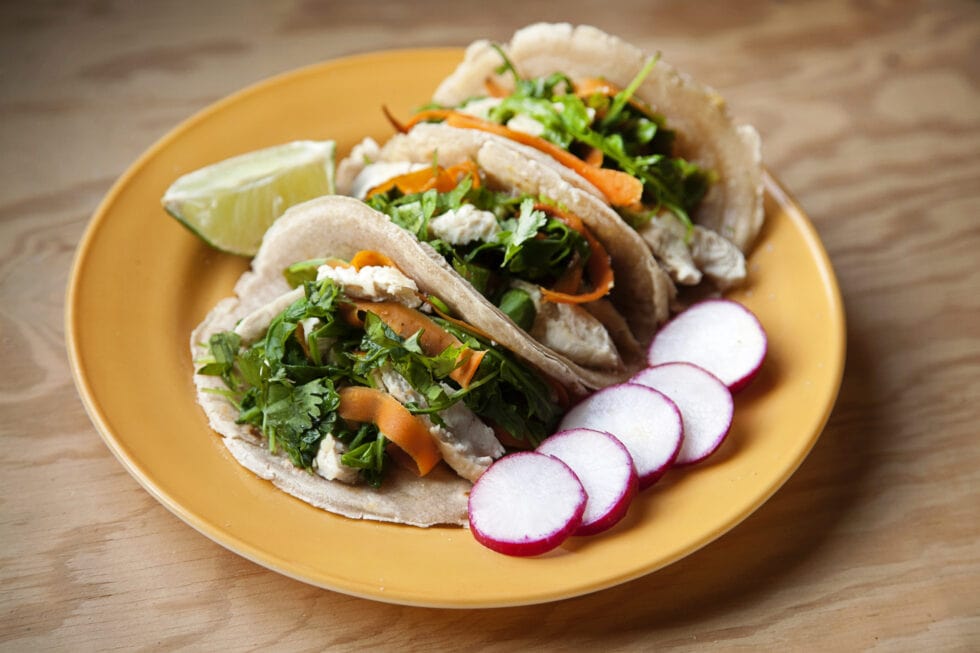
Low Histamine Tacos (also Low FODMAP, Low Oxalate, Low Lectin, with Low Salicylate option)
If you’re like me, some days you only have the energy to heat up frozen leftovers for your low histamine meal plans.
But you can keep preparation to a minimum AND get excited about eating leftovers with these tasty low FODMAP tacos!
On days when I have more energy, I can make a batch of cassava tortillas and an Instant Pot chicken.
And I can freeze leftovers into portions to have for those days I’m either busy or have mast cell flares.
Leftovers can be used in this recipe, and it makes it so easy.
Keep reading to learn how this recipe came together. And be sure to let me know when you try it yourself!
This taco recipe is:
- Low histamine
- Low FODMAP
- Low lectin
- Low oxalate to medium oxalate (options)
- Low salicylate (option)
- Gluten free
- Dairy free
Because this recipe blends fresh ingredients with frozen leftovers, it feels exciting, tasty, and satisfying.
Food is important for nutrition. But over the years, I’ve learned the importance food plays in our lives in other ways, too.
Here’s what I’ve learned about getting enjoyment from meals.
Before you change your diet on your own, make sure you’re working with a healthcare practitioner who can help you with this. Never limit foods unnecessarily, and always have a licensed medical provider who is supervising your case.
Why Low Histamine Low FODMAP Tacos
There was a time I couldn’t pull it together to make meals. So, I was cobbling things together – it was really just whatever I could manage steaming.
My meals got very boring very quickly.
I also became super aware of the significance of food in my life beyond nutrition.
Food is important culturally. And for our general life happiness and sense of contentment.
Enjoying some version of the foods passed down through our cultural heritage or family makes us feel part of something greater.
Food truly brings us a feeling of comfort and belonging. So, having foods that are familiar and that have lively, balanced flavors is really vital to our overall well-being.
And sharing meals with loved ones is a huge boost to life satisfaction.
In my long and winding food journey, I also learned how important flavor is to both emotional and mental health.
My mood was really low when I was eating a very restricted diet. I’m a “foodie” and love exciting flavors and variety. So, I felt depressed by the bland and boring diet that I was following.
One of my missions for my healing journey has been to come up with or share recipes that fulfill that need for flavor and satisfaction.
Related Post: Low Histamine Meal Planning
You may be just starting to learn how to eat low histamine. Or you could be figuring out how to deal with lectins, oxalates, or FODMAPs like I was.
I’ve found that a lot of people I talk to don’t know where to start adapting some of their favorite foods.
And that’s why we have several recipes here on the website that do just this. They help us provide variety, balanced flavors, and foods that are enjoyable. And hopefully a little bit of fun!
This yummy low histamine taco recipe was sent to us by one of our followers, Caroline. I adapted it to make a low FODMAP taco recipe and added a couple extra veggies.
Related Post: SIBO (Small Intestinal Bacterial Overgrowth)
How to Make Low FODMAP Tacos
Caroline got us started with this low histamine taco recipe.
In our community, I know some people are dealing with not only Histamine Intolerance but other food intolerances as well.
So, I wanted to have some options for you.
Keep reading to learn about the different options you have with this taco recipe!
But first, let me give you a big tip on choosing your protein.
Keeping Chicken Low Histamine
A lot of taco recipes use ground beef. If you have Histamine Intolerance, pre-ground beef is a higher histamine food.
If you are not as sensitive, you might be able to tolerate low histamine beef and grind your own. However, chicken might be your better option if you are still very sensitive.
That’s why we’re using chicken in this recipe.
Learn how meat can cause histamine issues by reading: Are you Raising your Histamine Levels with these Meat Handling Mistakes?
The first thing to think about when keeping chicken low histamine is to make sure you are starting with pasture raised chicken. This will reduce mast cell triggers in your meat.
The second thing is that it needs to be frozen right after slaughter. Otherwise, the histamine levels will be higher.
For pasture raised meats, my favorite sources are White Oak Pastures and Northstar Bison.
Check out all of White Oak Pastures’ low histamine meat options and search for chicken.
>>>Use coupon code MASTCELL360 for 10% off your first purchase!
Alternatively, you can also buy from Northstar Bison by searching for chicken.
>>>Use coupon code MASTCELL360 for 10% off!
And the third thing is in regard to cooking. The goal is to go as quickly as possible from frozen to cooked in order to keep histamine from building.
That’s why I love my Instant Pot.
You can cook a frozen chicken without having to thaw it first.
Being able to cook a larger amount of meat so easily is great if you are cooking for your whole family.
And if you are cooking for 1 or 2, you’ll have leftovers you can freeze and use another day.
Use this Low Histamine Chicken Recipe!
Freezing leftovers makes for easy meal prep for recipes like this low FODMAP taco recipe you’ll get in this post.
This is the Instant Pot I have:

If you don’t have an Instant Pot, use this oven roast chicken recipe.
Other Low Histamine Chicken Leftover Recipes
- Chicken Ginger Soup – Low Oxalate, Low Lectin, and Low FODMAP
- Spring Roll Stir Fry – Low Oxalate, Low Lectin, Low FODMAP, and Low Salicylate
- Baru Nut Crusted Chicken Over Salad – Low FODMAP, Low Lectin, and Medium to Low Oxalate Options
Now we’ve made sure your chicken is low in histamine. So, let’s move on to a couple of high FODMAP foods we’re going to replace.
Replacing High FODMAP Foods
FODMAPs are short-chain carbohydrates (sugars) found in some foods.
FODMAP is an acronym that stands for
- Fermentable
- Oligosaccharides
- Disaccharides
- Monosaccharides
- And
- Polyols
Remember, not everyone with Mast Cell Activation Syndrome or Histamine Intolerance has issues with FODMAPs.
And if you have FODMAP issues, you may not have trouble with all these categories of FODMAPs.
This is why it’s so important to work with your provider or someone like a registered dietitian who can help you determine the best course of action for your needs.
But you may already have some indications that you may have FODMAP Intolerance. For example, you are dealing with SIBO and Histamine Intolerance too.
And you may have FODMAP Intolerance if you have symptoms of Irritable Bowel Syndrome (IBS) like:
- Bloating
- Gas
- Constipation
- Diarrhea
FODMAP Intolerance is also common in Mold Toxicity!
Some common high FODMAP ingredients found in tacos include:
- Beans
- Cheddar cheese
- Sour cream
- Garlic
- Onions
In this recipe, you’ll get protein from chicken rather than beans.
You’ll skip the dairy for now. The dairy ingredients common in tacos like cheese and sour cream are high FODMAP.
But there are some concerns with histamine levels, too.
Some dairy isn’t high histamine. But aged foods, like aged cheddar cheese, are.
And fermented foods are higher histamine, too. So, you’ll want to steer clear of sour cream and even plain yogurt here.
Not only are they high histamine, but they have lactose and casein which can be mast cell triggers for some people. If you are in phase 1 of the Low Histamine Diet, skip these dairy foods for now to stay casein and lactose free.
Some of the hardest things I’ve found to replace in eating low FODMAP are onions and garlic.
These are flavors that are found in most of our savory foods. There’s nothing that quite tastes like garlic and onion.
When I first started focusing on low FODMAP foods, I couldn’t figure out an easy low FODMAP replacement for the garlic or onion flavor in my dishes. And foods just didn’t taste balanced anymore.
But once I learned these two FODMAP tricks, it was a game changer!
Let’s look at these two ingredients, onion and garlic, more closely.
Onion
If you don’t have FODMAP Intolerance, here’s why you’ll want to include onion in your meals.
Onion is low histamine. And it’s extremely high in quercetin – especially red onions.
Quercetin is a nutrient that has been shown in research studies to be beneficial for:
- Balancing the immune system
- Combating viruses
- Inhibiting histamine release
- Lowering inflammation
However, if you do have FODMAP Intolerance, here’s the trick to replacing onions to make these tacos low FODMAP.
Green onion (scallion) tops are low FODMAP. It’s ONLY the green tops that are low FODMAP. The whites are not.
Even a small amount of the white part is very high in fructans (a category of oligosaccharides, the O in FODMAP). And cooking doesn’t break down the FODMAPs.
Related Article: FODMAP Intolerance: What to Know if You Have Mast Cell Activation Syndrome or Histamine Intolerance
So, if you have trouble with onions, you might try green onion tops.
Chives and leek greens (not whites) may also be used.
This recipe uses green onion (scallion) tops.
Garlic
Like onions, garlic is low histamine and offers a lot of health benefits.
Several studies have shown benefits of garlic include:
- Lowering inflammation
- Enhancing immune function
- Fighting parasites and other infections
- Protecting the cardiovascular system
So, if you don’t have FODMAP issues, go ahead and include garlic in your recipes whenever you can.
However, like onions, garlic is really high in fructans. And that’s bad news if you have issues with that group of FODMAPs.
And, when people have FODMAP Intolerance, even smaller amounts of garlic and onions can be quite the digestive disaster.
If you’ve had to run to the bathroom in misery after eating too much of them, you know what I mean!
So, what can you do?
When you can find them, garlic scapes are very flavorful. Plus, they’re low FODMAP as well!
Another easy fix is to purchase or make garlic infused olive oil. It’s tolerated by most people.
I’ve tried a few different extra virgin olive oils to infuse with garlic. And I’ve found Kasandrinos has the best flavor. And it seems to be the best quality olive oil of the ones I’ve tried:
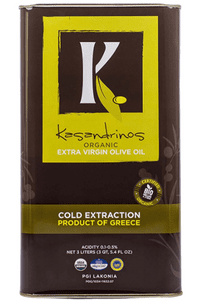
>>> Use code MASTCELL360 for 10% off any bottle or 50% off any olive oil subscription at Kasandrinos
Learn more about what to look for in low histamine olive oil here.
You don’t need a whole lot of garlic infused extra virgin olive oil to get amazing flavor.
If you prefer to make it yourself, I’ve included how to do that at the bottom of the low FODMAP tacos recipe.
Now, if you don’t have FODMAP Intolerance, then just use fresh garlic and onions. That’s perfectly fine if you tolerate them.
And in fact, garlic and onions contain sulfur compounds which are absolutely essential for mast cell stabilizing.
So, definitely don’t give up these foods unnecessarily!
This recipe really relies on these garlic and onion flavors. More traditional Mexican or Tex Mex style tacos will get bold flavor from ingredients like cumin, paprika, and chili powder.
But we won’t be using those since they are either high histamine and/or high oxalate.
So, whether you are using onion and garlic or their low FODMAP alternatives, these are critical components to big flavor!
Last, before we get to the recipe, I want to touch on other ways you can modify this recipe if you have other dietary needs beyond Histamine and FODMAP Intolerance.
Modifying the Low Histamine Taco Recipe
You might be in phase 1 of the Low Histamine Diet.
Or you might have Oxalate Intolerance.
Or you might have Salicylate Intolerance.
The great thing about this recipe is how versatile it is.
Here’s a breakdown of some other easy modifications you can make based on your needs and taste preferences.
Phase I vs Phase 2 of the Low Histamine Diet
There are some ingredients in this recipe which are more suitable if you are in phase 2 of the Low Histamine Diet.
Phase 2 is the re-introductory phase where you’ll start to slowly reintroduce higher histamine foods.
This taco recipe calls for some lime and a tiny pinch of cayenne. You might not be able to tolerate those ingredients just yet if you’re in phase 1 of the Low Histamine Diet.
Cayenne is higher histamine.
And lime and other citrus isn’t always tolerated in phase 1. Even at my worst, though, I was able to tolerate a squeeze of lemon or lime.
Everyone is different, so adjust based on your own needs.
Just omit these ingredients for now if you aren’t sure if you can tolerate them or not.
Oxalate Intolerance and What to Eat Instead
I added a couple of veggies to this recipe to boost the nutritional value and add some additional flavor.
One of the FODMAP friendly ingredients I added was carrots.
Carrots with their green, leafy tops intact are lower histamine than bagged carrots without tops.
Bagged carrots can sit on store shelves for months. Histamine levels will be higher in older foods.
Carrots are a great low histamine veggie to add to your tacos.
But here’s what you need to know if you have Oxalate Intolerance.
Carrots are higher oxalate if eaten raw.
If you find you are oxalate intolerant, you might want to skip the carrots in this recipe.
Related Article: Low Oxalate Diet
Alternatively, you may be able to tolerate carrots by boiling the carrots and discarding the water. A ½ cup of raw carrots is high oxalate, but boiling and discarding the cooking water will reduce it to medium oxalate.
I’m also using my cassava tortillas recipe for my taco shells instead of corn tortillas or flour tortillas.
Here’s what you need to know about cassava flour.
I only recommend Otto’s Cassava Flour.
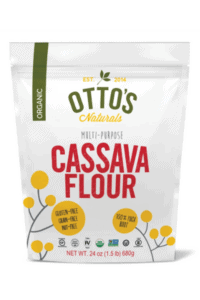
Otto’s is lower in oxalates than other cassava flours on the market.
>>>Use coupon MASTCELL360 for 10% off Otto’s Cassava Flour!
But cassava flour is still medium to high oxalate.
When Otto’s was tested, it registered as 17mg soluble oxalates per ¼ cup, which is high oxalate.
However, with oxalates, the amount you eat also matters. It’s high oxalate at ¼ cup of cassava flour. If a recipe comes out to ¼ cup of flour per serving, that recipe would be considered high oxalate.
If you’re using my cassava tortilla recipe, that pans out to one shell at just under ¼ cup for a 5-inch tortilla round.
If you don’t have oxalate issues at all, you’ll enjoy these cassava tortillas in any amount.
If you are mildly sensitive, you’ll probably want to stick to one tortilla.
And if you are very sensitive, you may prefer 1 of these 3 choices instead of a cassava tortilla.
- Taco bowl – You may want to have a “taco bowl” with no taco shell. This would be delicious on its own.
- Lettuce wrap – You could use lettuce as your shell and enjoy all the flavors of the low FODMAP taco in the form of a wrap. (I sometimes like the crispy element lettuce gives, too!) Be careful to not use a higher oxalate green like Swiss chard.
- Coconut wrap – You could use a coconut wrap if you are okay with salicylates and FODMAPs. We’ve found that packaged coconut products don’t build histamine like other packaged foods. This may be due to coconut’s antibacterial properties. You can use these coconut wraps.

Salicylate Intolerance and Low Histamine Tacos
I added arugula and carrots to Caroline’s low histamine taco recipe to give these tacos some extra flavor and nutrition.
Both arugula and carrots are FODMAP friendly.
However, you just read that carrots are a concern if you have Oxalate Intolerance.
They are also a concern if you have Salicylate Intolerance.
They are considered medium salicylate. So, they may be fine if you aren’t very sensitive.
However, if you are, you can consider omitting them or using a lesser amount.
You might also choose to substitute it with any of the low histamine, low salicylate vegetables you find of the Low Salicylate Food List.
In addition to carrots, you’ll see that I use arugula in this recipe. Arugula is a histamine lowering powerhouse food! And it’s low oxalate and low FODMAP.
And arugula is a great way to add a major punch to your recipes.
But it is higher salicylate.
Keep reading to learn about some of the benefits of arugula.
But first, here are some recipe modifications to consider if you have Salicylate Intolerance:
- Substitute chopped green/purple cabbage for the arugula
- Use a smaller amount of carrots
- Leave out the cayenne
- Instead of using garlic infused extra virgin olive oil, use garlic scape ghee
But if you can eat arugula, here are some benefits you’ll get.
Earlier, you read about the importance of sulfur in mast cell stabilizing. You can get sulfur from arugula. Just as you can from garlic and onions.
Arugula also has the added benefit of supporting something called nitric oxide production. Nitric oxide also happens to be mast cell stabilizing.
And arugula contains quercetin, which has been shown in studies to have anti-inflammatory properties. Learn more about the benefits of quercetin here.
With so many options, this taco recipe is sure to become a weekly favorite.
Let’s get to the recipe!
Low FODMAP Tacos
Serve these delicious tacos with:
- Low Histamine Mango Salsa – Low Oxalate and Low Lectin
- Iced Hibiscus Tea – Low Histamine, Low Oxalate, and Low Lectin
- Easy Mango Ice Cream – Low Histamine, Low Oxalate, and Low Lectin
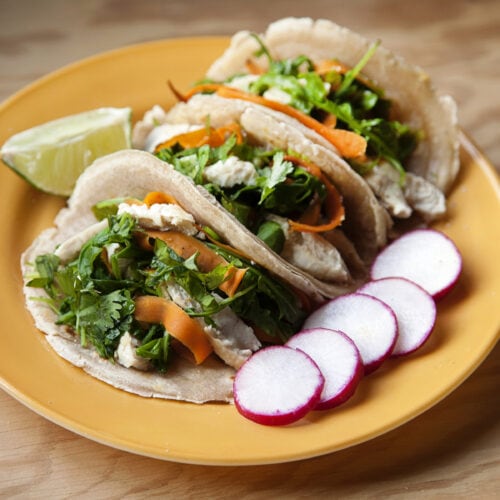
Low FODMAP Tacos
Equipment
- Sharp Knife
- Garlic Press optional
Ingredients
Low FODMAP Taco Filling
- 2 cups Low Histamine Chicken Breasts
- 1 clove Garlic minced OR
- 1 Tablespoon Garlic Infused Olive Oil
- 1 Tablespoon Ghee
- 2 Carrots with Green Tops cleaned and shredded
- 3 Green Onion Tops chopped (white bottoms are high FODMAP)
- 2 cups Baby Arugula chopped
- ½ teaspoon Redmond Real Salt
- ⅛ teaspoon Cayenne a pinch (optional)
- 2 Tablespoons Fresh Organic Cilantro chopped (optional)
- 1 teaspoon Fresh Organic Lime Juice freshly squeezed (optional)
Low Histamine Taco Shell Options (pick 1)
- 4 Cassava Tortillas
- 4 Coconut Wraps
- 4 Lettuce Wraps butter or iceberg
Homemade Low FODMAP Garlic Infused Olive Oil (optional)
- 3 cloves Garlic (cut in half for a stronger flavor)
- 1 cup Kasandrino’s Olive Oil
Instructions
Defrost Your Chicken
- Thaw your frozen, leftover chicken. Remember, you want to keep thaw times to a minimum to reduce histamine build up.
- The fastest and easiest way to defrost chicken is to put it in the microwave and use the defrost setting for about 1 minute at a time. I just go out of the room to avoid EMF exposure.
- Alternately, if your chicken is in a watertight container, you can submerge that container in a pot of cool water for about 1 hour until thawed. Times will depend on how much chicken you are thawing at one time. You can find some general guides online.
Optional Garlic Infused Olive Oil
- Peel garlic cloves and drop them in a sauté pan with 3 Tablespoons of olive oil.
- On medium heat, sauté the cloves for a few minutes, stirring often so they don’t burn or brown.
- Turn heat to low and add rest of olive oil. Stir while letting the oil warm for another 3 to 5 minutes.
- Using a strainer and a clean glass jar, pour the oil into the jar, straining all of the garlic pieces out.
- Store immediately in the fridge for up to 3 days. Or freeze the oil to keep longer.
- Don’t store the oil longer than three days because of the risk of botulism.
Low FODMAP Tacos
- Melt ghee in a large non toxic skillet over medium heat.
- If desired, add in the thawed, leftover chicken. Heat until warmed through. About 5 to 8 minutes.
- Add shredded carrots, minced garlic (if using), and green onion tops. Sauté for 4 to 5 minutes on medium heat, until vegetables start to soften. Add chopped arugula and cover with lid for 3 minutes on low heat, until wilted.
- Remove veggies from the skillet and set aside in a small bowl.
- Once warmed through, add veggies, and garlic infused EVOO to the chicken. (If you used a clove of garlic, skip this.)
- Sprinkle salt over meat and vegetables.
- If using, add optional cayenne.
- Stir to blend together.
- Take off heat.
- If using, top with cilantro and freshly squeezed lime juice.
- Serve with cassava tortillas, coconut wraps, or lettuce leaves.
- Freeze any leftovers before you start eating!
Notes
Nutrition
What did you come up with? I can’t wait to see your creative ideas!
Did you enjoy these low histamine and low FODMAP tacos for Taco Tuesday? Let us know in the comments!
More Low FODMAP Main & Side Dish Recipes
- Healthy Pad Thai – Low Lectin, Low Oxalate, and Low Salicylate Options
- Baked Fish – Low Oxalate, Low Lectin, and Low Salicylate
- Low Histamine Salad – Low Oxalate and Low Lectin
- Pesto – Low Oxalate and Medium Lectin
- Herbed Olive Oil and Cassava Flatbread – Medium Oxalate and Low Lectin
- Root Vegetable Mash – Low Lectin, Low Oxalate and Medium Oxalate Options
- Baked Chicken with Low FODMAP Herbs – Low Oxalate, Low FODMAP, Low Lectin
Some links in this website are affiliate links, which means Mast Cell 360 may make a very small commission if you purchase through the link. It never costs you any more to purchase through the links, and we try to find the best deals we can. We only recommend products that we love and use personally or use in the Mast Cell 360 practice. Any commissions help support the newsletter, website, and ongoing research so Mast Cell 360 can continue to offer you free tips, recipes, and info. Thank you for your support!
References
Adaki, S., et al. (2014). Garlic: Review of literature. Indian Journal of Cancer, 51(4), 577–581. https://doi.org/10.4103/0019-509x.175383
Alqasoumi, S. I., et al. (2009). Rocket “Eruca sativa”: A salad herb with potential gastric antiulcer activity. World Journal of Gastroenterology, 15(16), 1958. https://doi.org/10.3748/wjg.15.1958
Arreola, R., et al. (2015). Immunomodulation and Anti-Inflammatory Effects of Garlic Compounds. Journal of Immunology Research, 2015, 1–13. https://doi.org/10.1155/2015/401630
Coleman J. W. (2002). Nitric oxide: a regulator of mast cell activation and mast cell-mediated inflammation. Clinical and experimental immunology, 129(1), 4–10. https://doi.org/10.1046/j.1365-2249.2002.01918.x
FODMAP food list | Monash FODMAP. (n.d.). http://www.monashfodmap.com/about-fodmap-and-ibs/high-and-low-fodmap-foods/
HappyForks. (n.d.). Recipe analyzer. https://happyforks.com/analyzer/result#
Kim, B., Choi, Y. Y., & Kim, H. J. (2014). Eruca sativa and its Flavonoid Components, Quercetin and Isorhamnetin, Improve Skin Barrier Function by Activation of Peroxisome Proliferator-Activated Receptor (PPAR)-α and Suppression of Inflammatory Cytokines. Phytotherapy Research, 28(9), 1359–1366. https://doi.org/10.1002/ptr.5138
Mlček, J., et al. (2016). Quercetin and Its Anti-Allergic Immune Response. Molecules, 21(5), 623. https://doi.org/10.3390/molecules21050623
Nathiya, S., et al. (2014). Quercetin, Encapsulated Quercetin and Its Application – A Review. International journal of pharmacy and pharmaceutical sciences, 6(10), 1–26. https://www.researchgate.net/publication/286027853
Shaik, Y. B., et al. (2006). Role of quercetin (a natural herbal compound) in allergy and inflammation. Journal of biological regulators and homeostatic agents, 20(3-4), 47–52.
Shrivastava, N., et al. (2012). A Review of Quercetin: Antioxidant and Anticancer Properties. World journal of pharmacy and pharmaceutical sciences, 1(1), 146–160. https://www.researchgate.net/publication/267333748

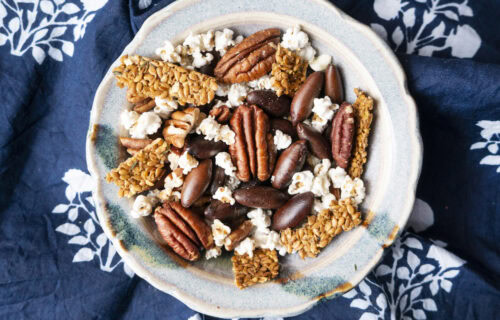
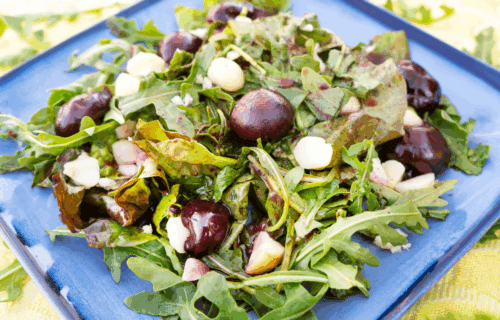

Thank Caroline for me and thank you for giving alternatives for low FODMAP and low Salicylates as in this stage of the game I have it all! I’m currently on a water fast but am adding the ingredients to my list for Friday’s grocery run and will have this Saturday! If it turns out as good as it looks then I’ll be making it again in February at a family get together for my brothers birthday so I can have something easy, yummy and portable for while they eat homemade pizza! I’ll be making your mango icecream (thank yu as that has been a lifesaver on a few special occasions) to enjoy while they have icecream cake!
I’m really confused about why you say peppers and rice are off the list? They are generally considered low histamine?
Hi Christine,
Rice and peppers are lower histamine, but rice and peppers are lectins. This recipe is listed as low lectin, so that is why rice and peppers are not options. If you don’t have issues with lectins and histamine is your only concern, you might be fine with rice and peppers.
This recipe was so so good! I baked the chicken with sweet paprika and then just chopped it up really small. Nice with a small smear of cream cheese on the tortilla.
So glad you liked it!